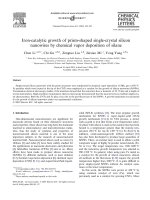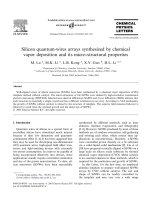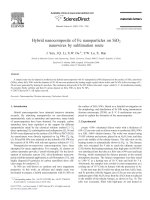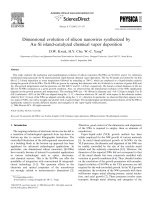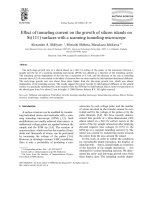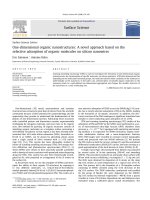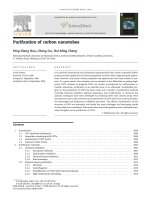- Trang chủ >>
- Khoa Học Tự Nhiên >>
- Vật lý
Deposition of carbon nanotubes on si nanowires by chemical vapor deposition
Bạn đang xem bản rút gọn của tài liệu. Xem và tải ngay bản đầy đủ của tài liệu tại đây (1.57 MB, 5 trang )
Deposition of carbon nanotubes on Si nanowires by chemical
vapor deposition
Y.F. Zhang, Y.H. Tang, Y. Zhang, C.S. Lee, I. Bello, S.T. Lee
*
Center of Super-Diamond & Advanced Films (COSDAF) and Department of Physics & Mater. Sci., City University of Hong Kong,
83 Tat Chee Avenue, Kowloon, Hong Kong, China
Received 19 July 2000
Abstract
By using a hot ®lament chemical vapor deposition (HFCVD) method, deposition of carbon on Si nanowires (Si
NWs) has been studied. Multi-walled carbon nanotubes (CNTs) were found to form on the surfaces of Si NWs at 900°C
with a good surface coverage and adherence. However, as the temperature of deposition increased to 1000°C, Si cores
tended to transform into b-SiC cores and the carbon layers grown on b-SiC cores were distorted. When the temperature
of deposition was as high as 1100°C, the carbon layers bucked openly to form many feather-like carbon sheets
sprouting from the surface of the nanowires. A mixture of large carbon sheets and b-SiC nanowires was formed when
the temperature was over 1300°C. Ó 2000 Elsevier Science B.V. All rights reserved.
1. Introduction
Carbon nanotubes (CNTs) [1] and Si nano-
wires (SiNWs) [2,3] have attracted considerable
attention in recent years because they have
demonstrated the potential to make a major con-
tribution to a variety of nanotechnological
applications [4±6]. It leads to speculations that the
modi®cation and combination of these two kinds
of nanomaterials, such as ®lling CNTs with silicon
or coating Si NWs with CNTs, will be more ro-
bust and result in an even more diverse range of
applications. Up to date, a composite of CNTs
with SiNWs in longitudinal has been synthesized
[7]. However, a composite of these two materials
in transversal has not been reported. Only CNTs
sheathed on other materials including in situ
growth in carbon gas mixtures and capillarity-
driven ®lling of open nanotubes by liquid reagents
have been reported as nanocables [8±11]. It should
be noticed that the percentage of ®lled nanocables
was practically either very low [9,11] or with very
small length to diameter ratios [10,11]. More re-
cently, we have reported a new oxide-assisted
growth method by which high-purity SiNWs can
be synthesized in large scale from a mixture of Si
and SiO
2
powders or from pure SiO powder [12±
15]. This supplied a good as-grown nanoscale
materials to synthesize a composite of CNTs and
SiNWs in transversal. Here, we report the syn-
thesis of this composite material by a hot ®lament
chemical vapor deposition (HFCVD) method.
The results provided a way to make CNTs coat
on SiNWs or SiC nanowires for further applica-
tions in both nanoscale electronic devices and
composite materials.
3 November 2000
Chemical Physics Letters 330 (2000) 48±52
www.elsevier.nl/locate/cplett
*
Corresponding author. Fax: +852-2784-4696.
E-mail address: (S.T. Lee).
0009-2614/00/$ - see front matter Ó 2000 Elsevier Science B.V. All rights reserved.
PII: S 0 0 0 9 - 2614(00)01084-8
2. Experimental
The as-grown Si NWs used in the present ex-
periment were produced by excimer pulsed laser
ablation of a target made of a mixture of Si and
SiO
2
powders under 9 Â 10
4
Pa Ar atmosphere at
1200°C. The experimental details were the same
as those reported in our previous paper [3]. The
experimental apparatus employed for coating the
Si NWs by CNTs was a bell-jar shaped RF-
plasma HFCVD system. One of the RF elec-
trodes made of a Mo sheet parallel to the ®lament
was used as the substrate holder. This sheet was
insulated from the water-cooled stainless
grounded supporter by putting it on a quartz
plate. The other RF electrode was placed 4 cm
above. The ®lament was placed between these two
RF electrodes. The distance between the substrate
and the ®lament could be adjusted. The as-grown
SiNWs were put on a silicon sheet as a substrate.
100 sccm gas ¯ow rate with 8% of methane in
hydrogen was fed from above the ®lament toward
SiNWs. The electrodes were supplied with a 13.56
MHz RF power source through a L±C matching
network. First, the amorphous silica outerlayer of
the as-grown SiNWs was removed by RF plasma
for 120 min with 300 W plasma power under
1X5 Â 10
2
Pa gas pressure at 300°C substrate
temperature. Then, the pre-carbonized tungsten
®lament above the substrate surface was electri-
cally heated to 2100°C. The temperature of the
substrate was measured to be 900°C. The carbon
deposition on SiNWs was carried out at 3 Â 10
3
Pa for 10 h.
3. Results and discussions
The as-grown SiNWs used in this experiment
for carbon coating were of high purity with a
whitish yellow color. Transmission electron mi-
croscope (TEM) image showed the nanowires to
have primarily smooth and uniform wire-like
structures (Fig. 1a). The average diameter was at
15 nm. Their lengths could extend up to a few
millimeters with nearly the same diameter
throughout the length. The structure of the
nanowires was con®rmed to consist of a crystalline
Si core and a silica outerlayer by using selected-
area electron diraction (SAED) pattern (inset of
Fig. 1a) and high resolution transmission electron
microscope (HREM) (Fig. 1b).
Fig. 1. (a) TEM image of the as-grown SiNWs. Inset is a SAED pattern; (b) HREM image of a typical SiNW.
Y.F. Zhang et al. / Chemical Physics Letters 330 (2000) 48±52 49
After the deposition, the color of the nanowires
changed to black. Fig. 2a showed the morphology
of carbon coated on SiNWs as observed with
scanning electron microscopy (SEM). It can be
seen that the nanowires remained as a web on the
Si substrate. Some carbon particles were also
found to co-exist during the carbon coating pro-
cesses. Fig. 2b showed a TEM image of the same
sample and its corresponding SAED pattern. The
diraction rings of crystalline cubic Si and b-SiC
could be identi®ed.
High resolution TEM images revealed that Si
NW with carbon coating consisted of a single
crystalline Si core and a sheath of carbon muti-
layers with an inter-layer spacing of 0.34 nm
(Fig. 3a). The multi-walled CNTs showed good
uniformity and adherence to the Si core. However,
there were also some disturbed interface areas of
CNTs and SiNWs. The original silicon dioxide
layer on the Si core disappeared, presumably due
to the etching eect of atomic hydrogen in the
plasma. Fig. 3b showed a nanowire with the b-SiC
core and a sheath of only a few carbon layers. It
had been noticed that two kinds of nanowires
shown in Fig. 3a, b were from the same specimen.
This case was owing to the poor thermal contact
between the nanowires themselves and also with
the Si substrate. So the temperatures of individual
nanowires were dicult to be kept uniform during
the carbon deposition process.
When the substrate temperature was increased
to 1100°C, electron diraction revealed that the
cores of the nanowires were transformed to b-SiC
completely. It could be seen from the electron
diraction pattern in the right bottom corner of
Fig. 4a. The carbon layers could not self-organize
into nanotubes completely and bucked to form
many feather-like sheets on the nanowire surface,
as shown in the upper image in Fig. 4a. A typical
nanowire in high magni®cation was shown more
clearly in the left bottom image in Fig. 4a. As the
deposition temperature increased to 1300°C, the
coated carbon grew to become large carbon sheets,
as shown in the bottom image in Fig. 4b. Even the
nanowires were completely carbonized and mixed
into a lot of carbon sheets to form a mixture of
Fig. 2. (a) SEM image of the web-like product; (b) corresponding TEM image and SAED pattern.
50 Y.F. Zhang et al. / Chemical Physics Letters 330 (2000) 48±52
b-SiC nanowires and graphitic carbon, as shown in
the top image in Fig. 4b.
The characteristics of carbon deposition on the
crystalline Si NW can be envisaged to be con-
trolled by both a template eect for the formation
of tube-like carbon shell structure and a carbon-
ization eect for the transformation of Si NWs to
SiC nanowires. At a relatively low substrate tem-
perature ($900°C), the deposition rate of carbon
on the surface of Si NWs was slow and if a carbon
nucleation happened on a nanowire surface, it was
possible that a carbon tube-like network formed
around the nanowire. As the diameters of the
nanowires were very small, tube-like carbon
structures were more stable than any other bulk
carbon structures. However, if the substrate tem-
perature was high enough ($1000°C) so that SiC
can be formed by carbon atoms diusing into the
Si NWs, CNTs could not be formed very well on
the surface of nanowires because of both the
volume change of the nanowires and breaking of
the carbon network sheathed on the nanowires.
When the substrate temperature was relatively
high (b1100°C), a mixture of graphitic carbon and
SiC nanowires was formed because of both the
carbonization of the nanowires and the fast carbon
deposition to form the carbon-like structure.
4. Conclusions
In summary, CNTs encapsulated crystalline
SiNWs were synthesized by the HFCVD method.
At $900°C, carbon multilayers were formed on
the surface of carbonized Si NWs. At a higher
reaction temperature ($1000°C), the silicon cores
reacted with carbon and transformed into b-SiC
cores. Carbon shells formed on the SiC core were
not as uniform as those on the Si core. As the
substrate temperature increased further to 1100°C,
Fig. 3. (a) HRTEM image of a nanowire consisting of a crystalline Si core and a sheath of multi-walled CNTs; (b) a nanowire with a
part of the core transformed into b-SiC and coated with a sheath of CNTs.
Y.F. Zhang et al. / Chemical Physics Letters 330 (2000) 48±52 51
feather-like carbon sheets sprouting from the sur-
face of the nanowires were formed. At an even
higher deposition temperature (1300°C), a mixture
of carbon pieces with b-SiC nanowires was ob-
tained.
Acknowledgements
The authors wish to thank Prof. F.H. Li and
Prof. X.F. Duan for useful discussions. This work
is supported by the Research Grants Council of
Hong Kong (Project no. 9040365).
References
[1] S. Iijima, Nature (London) 354 (1991) 56.
[2] A.M. Morales, C.M. Lieber, Science 279 (1998) 208.
[3] Y.F. Zhang, Y.H. Tang, N. Wang, C.S. Lee, I. Bello,
S.T. Lee, Appl. Phys. Lett. 72 (1998) 1835.
[4] A.G. Rinzler, J.H. Hafner, P. Nikolaev, L. Lou, S.G. Kin,
D. Tomanek, P. Nordlander, D.T. Colbert, R.E. Smalley,
Science 276 (1995) 1550.
[5] F.C.K. Au, K.W. Wong, Y.H. Tang, Y.F. Zhang, I. Bello,
S.T. Lee, Appl. Phys. Lett. 75 (1999) 1700.
[6] S.W. Chung, J.Y. Yu, J.R. Heath, Appl. Phys. Lett. 76
(2000) 2068.
[7] J. Hu, M. Ouyang, P. Yang, C.M. Lieber, Nature
(London) 399 (1999) 49.
[8] C.H. Wang, J.S. Choi, T.T. Tran, A.D. Bacher, J. Phys.
Chem. B 103 (1999) 7449.
[9] P.M. Ajayan, S. Iijima, Nature 361 (1993) 333.
[10] S.C. Tsang, Y.K. Chen, P.J.F. Harris, M.L.H. Green,
Nature 372 (1994) 159.
[11] J. Sloan, J. Hammer, M.Z. Sibbley, M.L.H. Green, Chem.
Commun. 3 (1998) 347.
[12] S.T. Lee, N. Wang, Y.F. Zhang, Y.H. Tang, MRS Bull. 24
(1999) 36.
[13] N. Wang, Y.H. Tang, Y.F. Zhang, C.S. Lee, S.T. Lee,
Phys. Rev. B 58 (1999) R16024.
[14] N. Wang, Y.H. Tang, Y.F. Zhang, C.S. Lee, I. Bello,
S.T. Lee, Chem. Phys. Lett. 299 (1999) 237.
[15] N. Wang, Y.F. Zhang, Y.H. Tang, C.S. Lee, S.T. Lee,
Appl. Phys. Lett. 73 (1998) 3902.
Fig. 4. (a) TEM image of the nanowires with carbon deposition at 1100°C, and a higher magni®cation image of a single nanowire in
the same sample at the left bottom corner and the corresponding SEAD pattern at the right bottom corner; (b) TEM image of the
nanowires with carbon deposition at $1300°C and the higher magni®cation image of a part of the sample in the upper image.
52 Y.F. Zhang et al. / Chemical Physics Letters 330 (2000) 48±52



